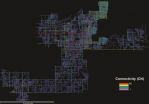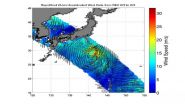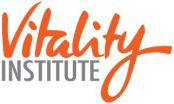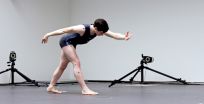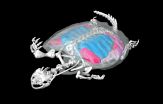(Press-News.org) HOUSTON -- ( Nov. 7, 2014 ) -- By transforming human scar cells into blood vessel cells, scientists at Houston Methodist may have discovered a new way to repair damaged tissue. The method, described in an upcoming issue of Circulation (early online), appeared to improve blood flow, oxygenation, and nutrition to areas in need.
Cardiovascular scientists at Houston Methodist, with colleagues at Stanford University and Cincinnati Children's Hospital, learned that fibroblasts -- cells that causes scarring and are plentiful throughout the human body -- can be coaxed into becoming endothelium, an entirely different type of adult cell that forms the lining of blood vessels.
"To our knowledge, this is the first time that trans-differentiation to a therapeutic cell type has been accomplished with a small molecules and proteins," said Houston Methodist Research Institute Department of Cardiovascular Sciences Chair John Cooke, M.D., Ph.D., the study's principal investigator. "In this particular case, we've found a way to turn fibroblasts into 'shapeshifters' nearly on command."
Cooke said the regenerative medicine approach provides proof-of-concept for a small molecule therapy that could one day be used to improve the healing of cardiovascular damage or other injuries.
Other research groups have managed to generate endothelial cells cells using infectious virus particles specially engineered to deliver gene-manipulating DNA to cells. The DNA encodes proteins called transcription factors to alter gene expression patterns in such a way that cells behave more like endothelial cells.
"There are problems with using viruses to transfer genes into cells," Cooke said. "This gene therapy approach is more complicated, and using viral vectors means the possibility of causing damage to the patient's chromosomes. We believe a small-molecule approach to transforming the cells will be far more feasible and safer for clinical therapies."
The new method described by Cooke and his coauthors starts with exposing fibroblasts to poly I:C (polyinosinic:polycytidylic acid), a small segment of double-stranded RNA that binds to the host cell receptor TLR3 (toll-like receptor 3), tricking the cells into reacting as if attacked by a virus. Cooke and coauthors reported to Cell in 2012 that fibroblasts' response to a viral attack -- or, in this case, a fake viral attack -- appears to be a vital step in diverting fibroblasts toward a new cell fate. After treatment with poly I:C, the researchers observed a reorganization of nuclear chromatin, allowing previously blocked-off genes to be expressed. The fibroblasts were then treated with factors, such as VEGF, that are known to compel less differentiated cells into becoming endothelial cells.
Cooke and his colleagues reported to Circulation that about 2 percent of the fibroblasts were transformed from fibroblasts into endothelial cells, a rate comparable to what other research groups have accomplished using viruses and gene therapy. But Cooke said preliminary, as-yet-unpublished work by his group suggests they may be able to achieve transformation rates as high as 15 percent.
"That's about where we think the yield of transformed cells needs to be," Cooke said. "You don't want all of the fibroblasts to be transformed -- fibroblasts perform a number of important functions, including making proteins that hold tissue together. Our approach will transform some of the scar cells into blood vessel cells that will provide blood flow to heal the injury."
In a second part of the study, the scientists introduced the transformed human cells into immune-deficient mice that had poor blood flow to their hind limbs. The human blood vessel cells increased the number of vessels in the mouse limb, improving circulation.
"The cells spontaneously form new blood vessels -- they self assemble," Cooke said. "Our transformed cells appear to form capillaries in vivo that join with the existing vessels in the animal, as we saw mouse red blood cells inside the vessels composed of human cells."
Cooke, who is also the director of the Houston Methodist Center for Cardiovascular Regeneration, said that figuring out how to manipulate adult cells of one type into becoming a completely different type of cell will be an important part of the development of regenerative medicine as a scientific and clinical field. Humans are generally unable to regenerate heavily damaged tissue, whereas other animals, such as some newts and flat worms, can regenerate entire lost limbs -- even entire heads.
"It is likely that modifications of this small molecule approach may be used to generate other body cells of therapeutic interest," Cooke said. "What we are seeing is evidence of the fluidity of cell fate with the proper stimulation. If we can understand the underlying pathways and how to manipulate them, we may very well learn how reawaken primordial mechanisms for regeneration that are active in lower vertebrates such as newts."
Cooke said more animal model studies are needed before his group begins clinical trials.
"One of the next steps will be to see if we can rescue an animal from an injury," Cooke said. "We want to know if the therapy enhances healing by increasing blood flow to tissues that may have been damaged by a loss of blood because of ischemia."
INFORMATION:
Also contributing to the Circulation paper were Nazish Sayed, M.D., Ph.D., Wing Tak Wong, Ph.D., Frank Ospino, and Shu Meng, Ph.D. (Houston Methodist Research Institute), Jieun Lee, Ph.D. and Arshi Jha (Stanford University School of Medicine), and Phillip Dexheimer and Bruce J. Aronow, Ph.D. (Cincinnati Children's Hospital Medical Center). Work was funded by the National Institutes of Health (U01HL100397, RC2HL103400, HL098049-01A1, and PCBC_JS_2012/1_02) and the American Heart Association (13SDG17340025 and 13SDG15800004).
To speak with John Cooke, please contact David Bricker, Houston Methodist, at 832-667-5811 or dmbricker@houstonmethodist.org.
LAWRENCE -- New study results from the University of Kansas to be presented this weekend at the Gerontological Society of America's annual meeting in Washington, D.C., bolster the adage that "heart healthy is brain healthy." The investigation shows neighborhoods that motivate walking can stave off cognitive decline in older adults.
"People can walk either to get somewhere or for leisure," said Amber Watts, assistant professor of clinical psychology, who will share her findings at a symposium Sunday, Nov. 9, in Liberty Salon K at the Washington Marriott Marquis.
"Depending ...
A detailed analysis by cybersecurity experts from the University of Maryland found that website administrators nationwide tasked with patching security holes exploited by the Heartbleed bug may not have done enough.
First disclosed in April 2014, Heartbleed presents a serious vulnerability to the popular OpenSSL (Secure Sockets Layer) software, allowing anyone on the Internet to read the memory of systems that are compromised by the malicious bug.
Assistant Research Scientist Dave Levin and Assistant Professor of Electrical and Computer Engineering Tudor Dumitras were ...
BOSTON (November 7, 2014) -- Researchers at Dana-Farber/Boston Children's Cancer and Blood Disorders Center have found a way to defeat one of the most tantalizing yet elusive target proteins in cancer cells - employing a strategy that turns the protein's own molecular machinations against it.
In a study published online by the journal Cell, the scientists used a specially crafted compound to disrupt the protein's ability to rev up its own production and that of other proteins involved in tumor cell growth. The result, in laboratory samples of neuroblastoma cancer cells ...
NASA's newest Earth observing mission, the International Space Station-Rapid Scatterometer, or ISS-RapidScat provided a look at the winds within post-tropical cyclone Nuri on Nov. 5 and 6 as it moved parallel to Japan. Nuri has moved across the Pacific and is expected to bring hurricane-force wind gusts to Alaska's Aleutian Islands today, Nov. 7.
"RapidScat passed over Nuri, near Japan, three times within a 24 hour period," said Doug Tyler of NASA's Jet Propulsion Laboratory, Pasadena, California. "The progression [in three images] showed Nuri's path."
RapidScat measured ...
New York - As Americans face growing health and financial burdens from preventable, non-communicable diseases such as cardiovascular disease, diabetes and certain cancers, a new study demonstrates employers have a unique opportunity to improve Americans' health. The research is led by Dr. Katherine Tryon and Dr. Derek Yach from the Vitality Institute and is published in the November issue of the Journal of Occupational and Environmental Medicine.
The study, which involved a first-of-its-kind comprehensive review of existing research into workplace health programs, notes ...
In a new study published in the scientific journal Oncotarget researchers from Uppsala University show that a therapeutic vaccine directed against tumor vessels can reduce tumor burden and suppress formation of spontaneous lung metastases in a mouse model for metastatic breast cancer.
The target molecule of the immunization strategy is the extra domain-A (ED-A) of fibronectin, a protein domain which is highly selective for the tumor vasculature in the adult.
"The vaccination approach we have employed is not prophylactic but therapeutic, meaning that immunity was induced ...
Tropical Cyclone 05B was meandering in the Bay of Bengal on Nov. 8, but forecasters expect it to move west and head toward east-central India for landfall. NASA-NOAA's Suomi NPP satellite captured a visible image of the tropical storm off India's coast.
When Suomi NPP flew over Tropical Cyclone 05B (TC05B) on Nov. 7 at 08:09 UTC (3:09 a.m. EST), the Visible Infrared Imaging Radiometer Suite or VIIRS instrument aboard captured a visible image of the storm. The VIIRS image showed a band of thunderstorms wrapping into the center from the northern quadrant, and fragmented ...
Amyotrophic lateral sclerosis (ALS) is a very severe disease that mainly affects the motor system. Recently the focus of public attention thanks to a viral campaign (remember last summer's ALS Ice Bucket Challenge?), ALS leads to progressive paralysis and ultimately death. Among the lesser known symptoms of the disease are cognitive impairments, which may even involve full-blown dementia. One of them is a selective difficulty in understanding and using verbs denoting actions, which these patients find much more challenging to process compared to nouns denoting objects. ...
This news release is available in German.
How can a sequence of dance steps best be learned? This question was the subject of a project led by researchers from Bielefeld University and the Palucca University of Dance in Dresden, who developed the study along with dancers and dance instructors. Together they researched whether dancers learn a dance sequence better by seeing or by listening, that is, if a dance instructor first demonstrates the sequence, or if he or she first gives a spoken explanation. The research article detailing the results of this study was recently ...
Through the careful study of modern and early fossil tortoise, researchers now have a better understanding of how tortoises breathe and the evolutionary processes that helped shape their unique breathing apparatus and tortoise shell. The findings published in a paper, titled: Origin of the unique ventilatory apparatus of turtles, in the scientific journal, Nature Communications, on Friday, 7 November 2014, help determine when and how the unique breathing apparatus of tortoises evolved.
Lead author Dr Tyler Lyson of Wits University's Evolutionary Studies Institute, the ...

